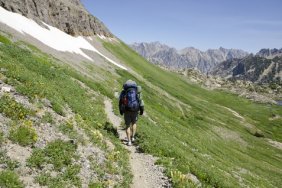 “Aren’t they all just boots?” “What’s the difference?” “Why are there so many?” These are just a few of the questions some people ask when they stand before the wall of hiking boots at their local outdoor retailer. Yes, it can be intimidating, but the key to finding a quality pair of boots is matching them to your needs. Terrain, pack load, and the duration of your trip are all factors in your decision, so be sure to know what you need, and then narrow the field to what you want. Today, we’ll being a three-part series on boot selection by highlighting some great models for day hikes to your local nature trail.
“Aren’t they all just boots?” “What’s the difference?” “Why are there so many?” These are just a few of the questions some people ask when they stand before the wall of hiking boots at their local outdoor retailer. Yes, it can be intimidating, but the key to finding a quality pair of boots is matching them to your needs. Terrain, pack load, and the duration of your trip are all factors in your decision, so be sure to know what you need, and then narrow the field to what you want. Today, we’ll being a three-part series on boot selection by highlighting some great models for day hikes to your local nature trail.
Unless you’re heading to rough, unstable terrain, you should really only need a mid-cut boot at most. Most day hikers don’t travel with full pack or try to negotiate hazardous footing, so a high cut boot may be overkill. Ankle cuts or even trail shoes are fine for short walks on even trails, but if you think you’ll be likely to climb hills or step over obstacles on potentially uneasy terrain often, than a good mid might be a better idea. This way, you’ll also have the added support if you do ever take a pack with you.
As far as low cut hiking shoes go, the Hedgehog III GTX hiking shoe ($120) from The North Face, is a great option. This lightweight shoe offers rubber heels and toe boxes to protect your feet against objects, waterproof Gore-Tex lining, and EVA midsoles that provide exceptional cushioning and shock-absorption.
Merrell’s Moab hiking shoe ($110) is another great option. This versatile shoe features waterproof, breathable membranes that allow your feet to breathe while still keeping them dry and comfortable. The shoe’s mesh lining is also treated with an antimicrobial solution to keep them from stinking.
If you’re one who maintains the philosophy that too much is better than not enough, then a mid-length boot might be a better bet for your day hikes. That way, you can grow into them, experience-wise, as your start to hike longer distances and carry more weight. Salomon’s X Ultra GTX mid is a good choice. At $160, it’s on the higher end of the price range, but with that you get a waterproof leather upper, breathable mesh panels, Gore-Tex liners, and moisture-wicking polyester lining. Keen’s Targhee II mid ($130) is another solid option. I may be biased, since they’re the boots I own and wear on the trail, but you can’t put a bias on quality. They’ve been reliable in deep snow, slick rocky climbs, and even moss-covered ledges on waterfalls, and are still some of the most comfortable shoes I’ve ever worn, on or off the trail.
The boots and shoes listed above are but a few of the dozens and dozens that are great for less rigorous day hikes. Like I said, mid-length boots are still a good option for easier treks, but they start to get into overnight and backcountry ratings, which we’ll cover in Part Two.








